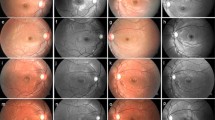Abstract
Purpose: To present a case of macular dystrophy with early changes in fundus autofluorescence. Methods: A 20-year-old woman with a recent loss of visual acuity and onset of photophobia was examined. Color vision and visual field testing, fluorescein angiography, full-field and multifocal electroretinograms as well as fundus autofluorescence were performed. Results: Best-corrected visual acuity was 20/100 (right eye) and 20/60 (left eye). There was a red-green color vision defect and a relative central scotoma in both eyes. Ophthalmoscopy and fluorescein angiography were essentially normal, the presence of a dark choroid was debatable. Full-field ERG responses were normal, but the multifocal ERG showed severely reduced responses in the macular region. Both eyes showed a slight circular parafoveolar increase of fundus autofluorescence. Conclusion: Besides multifocal ERG, fundus autofluorescence aids to objectively assess the manifestation of macular dystrophies but does not discern between different types in early stages.





Similar content being viewed by others
References
Miyake Y, Ichikawa K, Shiose Y et al (1989) Hereditary macular dystrophy without visible fundus abnormality. Am J Ophthalmol 108:292–299
Matthews GP, Sandberg MA, Berson EL (1992) Foveal cone electroretinograms in patients with central visual loss of unexplained etiology. Arch Ophthalmol 110:1568–1570
Kellner U, Foerster H (1993) Pattern of dysfunction in progressive cone dystrophies – an extended classification. German J Ophthalmol 2:170–177
Lyons JS (2005) Non-familial occult macular dystrophy. Doc Ophthalmol 111:49–56
Miyake Y, Horiguchi M, Tomita N et al (1996) Occult macular dystrophy. Am J Ophthalmol 122:644–653
Kondo M, Ito Y, Ueno S et al (2003) Foveal thickness in occult macular dystrophy. Am J Ophthalmol 135:725–728
Kellner U, Jandeck C, Kraus H et al (1998) Hereditary macular dystrophies. Ophthalmologe 95:597–601
Fish G, Grey S, Sehme KS et al (1981) The dark choroid in posterior retinal dystrophies. Br J Ophthalmol 65:359–363
Louis N, Halfyard AS, Bird AC et al (2004) Fundus autofluorescence in Stargardt macular dystrophy-fundus flavimaculatus. Am J Ophthalmol 138:55–63
Marmor MF, Holder GE, Seeliger MW et al (2004) Standard for clinical electroretinography (2004 update). Doc Ophthalmol 108:107–114
Marmor MF, Hood DC, Keating D et al (2003) Guidelines for basic multifocal electroretinography (mfERG). Doc Ophthalmol 106:105–115
Gerth C, Andrassi-Darida M, Bock M et al (2002) Phenotypes of 16 Stargardt macular dystrophy/fundus flavimaculatus patients with known ABCA4 mutations and evaluation of genotype–phenotype correlation. Graefes Arch Clin Exp Ophthalmol 240:628–638
Ebenezer ND, Michaelides M, Jenkins SA et al (2005) Identification of novel RPGR ORF15 mutations in X-linked progressive cone-rod dystrophy (XLCORD) families. Invest Ophthalmol Vis Sci 46:1891–1898
Michaelides M, Holder GE, Hunt DM et al (2005) A detailed study of the phenotype of an autosomal dominant cone-rod dystrophy (CORD7) associated with mutation in the gene for RIM1. Br J Ophthalmol 89:198–206
Von Rückmann A, Fitzke FW, Bird AC (1995) Distribution of fundus autofluorescence with a scanning laser ophthalmoscope. Br J Ophthalmol 79:407–412
Sparrow JR, Boulton M (2005) RPE lipofuscin and its role in retinal pathobiology. Exp Eye Res 80:595–606
Sanyal S, Hawkins RK (1989) Development and degeneration of retina in rds mutant mice: altered disc shedding pattern in the heterozygotes and its relation to ocular pigmentation. Curr Eye Res 8:1093–1101
Okubo A, Sameshima M, Unoki K et al (2000) Ultrastructural changes associated with accumulation of inclusion bodies in rat retinal pigment epithelium. Invest Ophthalmol Vis Sci 41:4305–4312
Kennedy CJ, Rakoczy PE, Constable IJ (1995) Lipofuscin of the retinal pigment epithelium: a review. Eye 9:763–771
Scholl HPN, Chong VNH, Robson AG et al (2004) Fundus autofluorescence in patients with Leber congenital amaurosis. Invest Ophthalmol Vis Sci 45:2747–2752
Author information
Authors and Affiliations
Corresponding author
Rights and permissions
About this article
Cite this article
Poloschek, C.M., Hansen, L.L. & Bach, M. Annular fundus autofluorescence abnormality in a case of macular dystrophy. Doc Ophthalmol 116, 91–95 (2008). https://doi.org/10.1007/s10633-007-9097-2
Received:
Accepted:
Published:
Issue Date:
DOI: https://doi.org/10.1007/s10633-007-9097-2




